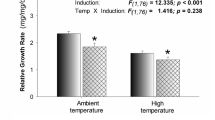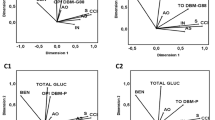Abstract
In this study, the performance and sequestration specificity of the sawfly Athalia rosae L. (Hymenoptera: Tenthredinidae) reared on two wild Brassica oleracea L. (Brassicaceae) populations (KIM and WIN), which express indole glucosinolates (GSs) in very high concentrations, were investigated. The local and systemic plant responses to larval feeding also were analyzed. Indole GSs predominated in KIM plants, whereas aliphatic GSs prevailed in the WIN population, which had several times higher total GS concentrations than KIM plants. Plants of the KIM population had lower specific leaf areas, and higher carbon/nitrogen ratios than WIN plants. The insects reared on WIN plants performed better for most traits than insects reared on the KIM population. The larvae preferentially sequestered aliphatic GSs but when feeding on KIM plants, indole GSs were also concentrated in the hemolymph. In response to feeding by A. rosae larvae, indole GSs were induced locally and systemically, whereas aliphatic GSs were reduced only in systemic leaves of the WIN population. Soluble myrosinase activities were constitutively higher in WIN than in KIM plants, and feeding damage led to a significant reduction of this glucosinolate-degrading enzyme in WIN plants only. The data suggest that the sawfly is well adapted to high concentrations of aliphatic GSs, which are sequestered by the larvae. In contrast, the larvae may be less adapted to plants dominated by indole GSs. Selective induction of indole GSs by the plants in response to larval feeding may be adaptive as accumulation of indole GSs may lower the performance of the larvae.



Similar content being viewed by others
References
Agerbirk, N., Olsen, C. E., and Nielsen, J. K. 2001. Seasonal variation in leaf glucosinolates and insect resistance in two types of Barbarea vulgaris ssp. arcuata. Phytochemistry 58:91–100.
Agerbirk, N., de Vos, M., Kim, J. H., and Jander, G. 2009. Indole glucosinolate breakdown and its biological effects. Phytochem. Rev. 8:101–120.
Benjamini, Y. and Hochberg, Y. 1995. Controlling the false discovery rate - a practical and powerful approach to multiple testing. J. Roy. Stat. Soc. B. Met. 57:289–300.
Bernardi, R., Finiguerra, M. G., Rossi, A. A., and Palmieri, S. 2003. Isolation and biochemical characterization of a basic myrosinase from ripe Crambe abyssinica seeds, highly specific for epi-progoitrin. J. Agric. Food Chem. 51:2737–2744.
Björkman, R. and Lonnerda, B. 1973. Studies on myrosinases. 3. enzymatic properties of myrosinases from Sinapis alba and Brassica napus seeds. Biochim. Biophys. Acta 327:121–131.
Bradford, M. M. 1976. Rapid and sensitive method for quantitation of microgram quantities of protein utilizing principle of protein-dye binding. Anal. Biochem. 72:248–254.
Discher, S., Burse, A., Tolzin-Banasch, K., Heinemann, S. H., Pasteels, J. M., and Boland, W. 2009. A versatile transport network for sequestering and excreting plant glycosides in leaf beetles provides an evolutionary flexible defense strategy. ChemBioChem 10:2223–2229.
Gershenzon, J. and Müller, C. 2009. Phytochemistry reviews-special issue on glucosinolates PREFACE. Phytochem. Rev. 8:1–2.
Gols, R., Wagenaar, R., Bukovinszky, T., van Dam, N. M., Dicke, M., Bullock, J. M., and Harvey, J. A. 2008. Genetic variation in defense chemistry in wild cabbages affects herbivores and their endoparasitoids. Ecology 89:1616–1626.
Halkier, B. A. and Gershenzon, J. 2006. Biology and biochemistry of glucosinolates. Annu. Rev. Plant. Biol. 57:303–333.
Harvey, J. A., Gols, R., Wagenaar, R., and Bezemer, T. M. 2007. Development of an insect herbivore and its pupal parasitoid reflect differences in direct plant defense. J. Chem. Ecol. 33:1556–1569.
Harvey, J. A., van Dam, N. M., Raaijmakers, C. E., Bullock, J. M., and Gols, R. 2011. Tri-trophic effects of inter- and intra-population variation in defence chemistry of wild cabbage (Brassica oleracea). Oecologia 166:421–431.
Hopkins, R. J., van Dam, N. M., and van Loon, J. J. A. 2009. Role of glucosinolates in insect-plant relationships and multitrophic interactions. Annu. Rev. Entomol. 54:57–83.
ISO 9167 I. 1992. Rapeseed- Determination of glucosinolate content-Part 1: Method using high-performance liquid chromatography. ISO 9167 1:1–9.
Kazana, E., Pope, T. W., Tibbles, L., Bridges, M., Pickett, J. A., Bones, A. M., Powell, G., and Rossiter, J. T. 2007. The cabbage aphid: a walking mustard oil bomb. Proc. Roy. Soc. Lond. B Bio. 274:2271–2277.
Kim, J. H. and Jander, G. 2007. Myzus persicae (green peach aphid) feeding on Arabidopsis induces the formation of a deterrent indole glucosinolate. Plant J. 49:1008–1019.
Kos, M., Kabouw, P., Noordam, R., Hendriks, K., Vet, L. E. M., van Loon, J. J. A., and Dicke, M. 2011. Prey-mediated effects of glucosinolates on aphid predators. Ecol. Entomol. 36:377–388.
Martin, N. and Müller, C. 2007. Induction of plant responses by a sequestering insect: Relationship of glucosinolate concentration and myrosinase activity. Basic Appl. Ecol. 8:13–25.
Mithen, R., Raybould, A. F., and Giamoustaris, A. 1995. Divergent selection for secondary metabolites between wild populations of Brassica oleracea and its implications for plant-herbivore interactions. Heredity 75:472–484.
Moyes, C. L., Collin, H. A., Britton, G., and Raybould, A. E. 2000. Glucosinolates and differential herbivory in wild populations of Brassica oleracea. J. Chem. Ecol. 26:2625–2641.
Müller, C. 2009. Interactions between glucosinolate- and myrosinase-containing plants and the sawfly Athalia rosae. Phytochem. Rev. 8:121–134.
Müller, C. and Brakefield, P. M. 2003. Analysis of a chemical defense in sawfly larvae: Easy bleeding targets predatory wasps in late summer. J. Chem. Ecol. 29:2683–2694.
Müller, C. and Sieling, N. 2006. Effects of glucosinolate and myrosinase levels in Brassica juncea on a glucosinolate-sequestering herbivore - and vice versa. Chemoecology 16:191–201.
Müller, C., Agerbirk, N., Olsen, C. E., Boevé, J.-L., Schaffner, U., and Brakefield, P. M. 2001. Sequestration of host plant glucosinolates in the defensive hemolymph of the sawfly Athalia rosae. J. Chem. Ecol. 27:2505–2516.
Müller, C., Boevé, J.-L., and Brakefield, P. 2002. Host plant derived feeding deterrence towards ants in the turnip sawfly Athalia rosae. Entomol. Exp. Appl. 104:153–157.
Müller, C., Zwaan, B. J., de Vos, H., and Brakefield, P. M. 2003. Chemical defence in a sawfly: genetic components of variation in relevant life-history traits. Heredity 90:468–475.
Opitz, S. E. W. and Müller, C. 2009. Plant chemistry and insect sequestration. Chemoecology 19:117–154.
Opitz, S. E. W., Jensen, S. R., and Müller, C. 2010. Sequestration of glucosinolates and iridoid glucosides in sawfly species of the genus Athalia and their role in defense against ants. J. Chem. Ecol. 36:148–157.
Opitz, S. E. W., Mix, A., Winde, I. B., and Müller, C. 2011. Desulfation followed by sulfation - metabolism of benzylglucosinolate in Athalia rosae (Hymenoptera:Tenthredinidae). Chem. Bio. Chem. 12:1252–1257.
Poorter, L., de Plassche, M. V., Willems, S., and Boot, R. G. A. 2004. Leaf traits and herbivory rates of tropical tree species differing in successional status. Plant Biol. 6:746–754.
R Developmental Core Team. 2011. R: a language and environment for statistical computing. Vienna, Austria: R Foundation for Statistical Computing. URL http://www.R-project.org.
Textor, S. and Gershenzon, J. 2009. Herbivore induction of the glucosinolate-myrosinase defense system: major trends, biochemical bases and ecological significance. Phytochem. Rev. 8:149–170.
Tolzin-Banasch, K., Dagvadorj, E., Sammer, U., Kunert, M., Kirsch, R., Ploss, K., Pasteels, J. M., and Boland, W. 2011. Glucose and glucose esters in the larval secretion of Chrysomela lapponica; selectivity of the glucoside import system from host plant leaves. J. Chem. Ecol. 37:195–204.
Travers-Martin, N. and Müller, C. 2007. Specificity of induction responses in Sinapis alba L. and their effects on a specialist herbivore. J. Chem. Ecol. 33:1582–1597.
Travers-Martin, N. and Müller, C. 2008. Matching plant defense syndromes with performance and preference of a specialist herbivore. Funct. Ecol. 22:1033–1043.
Travers-Martin, N., Kuhlmann, F., and Müller, C. 2008. Revised determination of free and complexed myrosinase activities in plant extracts. Plant Physiol. Bioch. 46:506–516.
Whitfeld, T. J. S., Novotny, V., Miller, S. E., Hrcek, J., Klimes, P., and Weiblen, G. D. 2012. Predicting tropical insect herbivore abundance from host plant traits and phylogeny. Ecology 93:S211–S222.
Winde, I. and Wittstock, U. 2011. Insect herbivore counteradaptations to the plant glucosinolate-myrosinase system. Phytochemistry 72:1566–1575.
Wittstock, U., Kliebenstein, D. J., Lambrix, V., Reichelt, M., and Gershenzon, J. 2003. Glucosinolate hydrolysis and its impact on generalist and specialist insect herbivores, pp. 101–125, in J. T. Romeo (ed.), Recent Advances in Phytochemistry. Pergamon, Amsterdam, The Netherlands.
Wittstock, U., Agerbirk, N., Stauber, E. J., Olsen, C. E., Hippler, M., Mitchell-Olds, T., Gershenson, J., and Vogel, H. 2004. Successful herbivore attack due to metabolic diversion of a plant chemical defense. Proc. Natl. Acad. Sci. U. S. A. 101:4859–4864.
Acknowledgments
The authors thank J.A. Harvey and R. Gols (Netherland Institute for Ecology, Wageningen, The Netherlands) for providing seeds of wild B. oleracea populations, D. Balten and coworkers for help in plant cultivation, J. Niekamp for help in insect rearing, and R. Sutter for practical help. This work was in part funded by a co-financed scholarship between the Ministry of Higher Education and Scientific Research (MHESR), Egypt, and the German Academic Exchange Service (DAAD) to M. K. Abdalsamee.
Author information
Authors and Affiliations
Corresponding author
Rights and permissions
About this article
Cite this article
Abdalsamee, M.K., Müller, C. Effects of Indole Glucosinolates on Performance and Sequestration by the Sawfly Athalia rosae and Consequences of Feeding on the Plant Defense System. J Chem Ecol 38, 1366–1375 (2012). https://doi.org/10.1007/s10886-012-0197-4
Received:
Revised:
Accepted:
Published:
Issue Date:
DOI: https://doi.org/10.1007/s10886-012-0197-4




